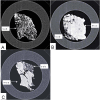Microdissection of Human Esophagogastric Junction Wall with Phase-contrast X-ray CT Imaging
- PMID: 26346099
- PMCID: PMC4561904
- DOI: 10.1038/srep13831
Microdissection of Human Esophagogastric Junction Wall with Phase-contrast X-ray CT Imaging
Abstract
Phase-contrast x-ray imaging using an x-ray interferometer has great potential to reveal the structures inside soft tissues, because the sensitivity of this method to hydrogen, carbon, nitrogen, and oxygen is about 1000 times higher than that of the absorption-contrast x-ray method. In this study, we used phase-contrast X-ray CT to investigate human resected esophagogastric junction. This technology revealed the three-layer structure of the esophagogastric junction wall-mucous, submucosa and muscular layers. The mucous and muscular layers were clearly separated by a loose submucosa layer with a honeycomb appearance. The shape of the mucous and muscular layers was intact. The boundary between the mucous and submucosa layers was distinct, as was the border of the muscular and submucosa layers. The surface of the esophagogastric junction was displayed clearly through 3D reconstruction. The technology might be helpful in the diagnosis of esophagogastric junction lesion, especially for the early adenocarcinoma.
Figures





References
Publication types
MeSH terms
LinkOut - more resources
Full Text Sources
Other Literature Sources
Medical

